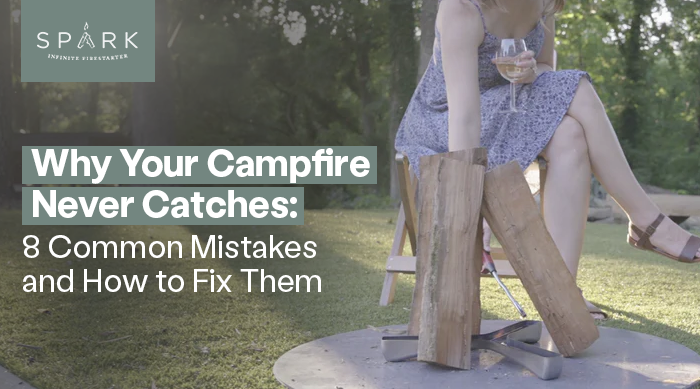Summary
- Wet or green wood is the fastest way to kill your fire before it even starts.
- Every good fire begins with tinder and kindling, not big logs.
- Fire can’t survive without oxygen, so don’t pack your wood too tight.
- Too much space between sticks is just as bad because the flame can’t spread.
- Wind can blow your fire out, but you can use it to your advantage with the right setup.
- Big logs only work once you already have a solid bed of hot coals.
- Cold, damp ground will suck the heat right out of your fire.
- Constant poking weakens your fire instead of helping it grow.
Ever sat in front of a pile of wood, struck match after match, and still ended up with nothing but smoke? You’re not alone. Most campers have been there, staring at a stubborn fire pit while their friends await marshmallows. The truth is, getting a fire to catch isn’t magic; it’s a skill. And the good news? Anyone can learn it.
Here’s the thing, if your campfire isn’t catching, it’s usually not because you’re unlucky; it’s because of a few simple mistakes that are easy to fix once you know them. You can go from frustration to a roaring blaze in minutes with the right approach.
Let’s go through the eight most common reasons your campfire won’t catch, and the easy fixes that will make your fire a whole lot easier next time (and way less smoky).
Your Fuel Is Wet or “Green”
If your wood hisses, steams, and smokes more than it burns, chances are it’s too wet. Freshly cut or “green” wood contains a lot of moisture. Instead of fueling a flame, your fire wastes its energy boiling away water, leaving nothing behind for actual combustion.
Always aim for dry, seasoned wood. This is wood that’s been cut and left to dry for at least six months. Avoid anything lying flat on damp ground if you’re gathering wood in the wild. Look for branches still attached to dead trees; they’re usually drier and burn much better.
You’re Skipping the Fire-Building Stages
Trying to light a log directly with a match or a single piece of paper is like trying to run a marathon without warming up. Fires need to be built in stages so they can grow gradually.
Think of fire in three layers:
-
Tinder: Dry grass, shredded bark, cotton balls, or even dryer lint. This is what catches your spark.
-
Kindling: Pencil to thumb-sized sticks that catch flame from the tinder and build heat.
-
Fuel Wood: Your main logs sustain the fire once you have a hot bed of coals.
Gather plenty of each before you strike a match. That way, you’re not scrambling to add more fuel at the wrong time.
Want to know more about why starting a fire can be so frustrating and how the right tool changes everything? Check out this article on why a great fire starter matters.
You’re Starving the Fire of Oxygen
If you pack wood and kindling too tightly, you choke your fire before it can grow. Fire is a chemical reaction, and oxygen is one of its main ingredients. Without it, your flames suffocate.
Build your fire in a way that promotes airflow. Classic structures like the teepee and log cabin are popular because they naturally create gaps for oxygen to move through. Always leave enough breathing room between your fuel pieces to let air in from below.
Curious about the science behind Spark’s build? Learn more about why its stainless steel design makes it so durable and reliable.
Your Fire Structure Is Too Loose
On the flip side, spacing your kindling too far apart means heat can’t transfer from one piece to another. The flame needs contact to spread; without it, your fire flickers out before it gets started.
Keep your tinder and kindling pile compact at the start. You want the flames to reach the next stick easily. Once your fire is burning strongly, you can space your fuel wood more widely to allow airflow.
You’re Ignoring the Wind
A small flame is fragile. A strong gust can blow it out before it’s had a chance to grow. On breezy nights, the wind can be your biggest enemy at the beginning stages of a fire.
Use the wind to your advantage. Set up near a natural windbreak like a log, boulder, or even your backpack. When lighting your tinder, position your body to block gusts. Once the fire is burning well, a light breeze is actually helpful because it feeds your fire with oxygen.
Want to dig deeper into the emotional side of sitting around a fire? Here’s a great read on the benefits of having a campfire.
You’re Starting with Logs That Are Too Big
Big logs are tempting, but they take a lot of heat to ignite. Dropping one onto a small flame usually ends with the fire being smothered instead of growing.
Be patient. Start small with tinder, then build up gradually with kindling and medium-sized sticks. Save the larger logs for when you have a solid bed of glowing embers. That heat will be strong enough to catch the bigger wood and keep your fire going for hours.
You’re Building on Cold, Damp Ground
Even if your wood and structure are perfect, starting on wet ground can ruin your efforts. The cold, damp earth sucks heat away like a sponge, leaving your flame with no chance to grow.
Create a dry base for your fire. Lay down a platform of dry sticks, bark, or even a flat bed of rocks before placing your tinder and kindling. This insulation keeps the ground from stealing your fire’s energy.
You’re Poking the Fire Too Soon (and Too Much)
It’s tempting to keep adjusting logs, moving sticks, and poking at the flames, but constant meddling collapses the structure and disperses the heat. Young fires need stability to catch and grow.
Trust your setup. Once it’s lit, step back and give it a chance to do its thing. If you need to intervene, the only thing you should do is give a gentle, steady blow at the base of the flame to feed it oxygen. Otherwise, let the fire build strength naturally.
Conclusion
At the end of the day, campfire success isn’t about dumb luck; it’s about preparation and technique. With the right fuel, a solid structure, and good airflow, your chances of failure drop dramatically.
And if you want a shortcut to a reliable blaze, consider the Spark Firestarter. Its stainless steel design and alcohol-powered flame give you a strong, steady start that takes away the hardest part of building a fire. No scrambling for dry tinder, no endless matches, just a clean flame that makes campfire building simple.
Pair the right technique with the right tool, and you’ll have a warm, roaring fire every time you strike a spark.

